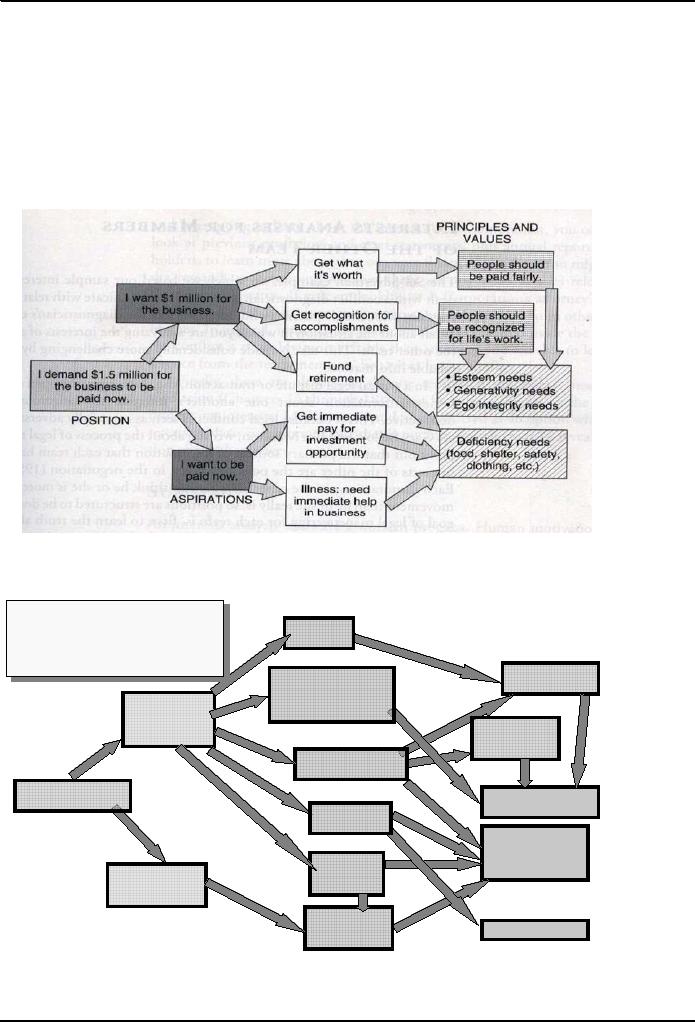 |

Conflict
Management HRM624
VU
Lesson
14
INTEREST
ANALYSIS II
Quotation
The
interest of the landlord is always
opposed to the interests of every
other class in the community. David
Ricardo
(1772
- 1823) British political
economist.
We
have no eternal allies and
we have no perpetual enemies. Our
interests are eternal and
perpetual, and
those
interests it is our duty to
follow.
Lord
Palmerston (1784
- 1865) British prime minister. Speech to
the British Parliament
In the previous
lecture, we talked about the analysis of
interests. How interests of
conflict participants are
important
to understand the nature of conflict.
The analysis of interests
helps diagnose conflict
greatly. The
deeper
understanding of the sources of conflict,
both superficial and deep, could
help resolve conflict
successfully
and favorably.
Conflict
in its collective sense is sometimes
defined as a condition, sometimes as a
process, and
sometimes
as an
event. Conflict can be taken
as a challenge and could be transformed
into an opportunity.
Analyzing
the interests of constituents and
stakeholders
Constituents
and stakeholders are
affected by the course and
outcome of a conflict; in turn,
their
connection to the
disputants can lead to their
significantly affecting the settlement, or potential
settlements,
made
by the disputants, for good or
for ill. Uncover conflicting
interests that might lead to
undermining
negotiation
or sabotaging a settlement.
Improve
the ultimate result by taking account of
what others are likely to
do. For example in a divorce
case,
the children's
interests should be analyzed carefully.
Apart from the moral responsibility the
adults in the
situation to
act in the best interests of
these children, it is highly likely that,
without an understanding of the
children's
interests, the children will
themselves contribute to the destruction of the
agreements made by
the
grown ups. Children also
attempt to create a secure relationship
between themselves and each
parent by
telling
each parent what the children think the
parents want to hear.
Analyzing
the interests of all participants is
important as any participant could
sabotage the settlement of
the
dispute.
An
interest analysis should also include the
agents and advocates for the
other disputant. This is because
the
interests
of other participants in the conflict can
add to the complexity of motivations
driving behavior in
the
conflict.
50

Conflict
Management HRM624
VU
Advantages of
interests analysis
Clarifies
what the disputant really
wants and needs
The
Disputant
Enables
the disputant to consider whether
interests, values,
and
needs would be better met
outside the conflict
Enables
greater flexibility and creativity in
crafting solutions
Avoids
the pitfalls of positional
bargaining.
The
other disputant Enables the
negotiator to craft appealing
proposals
Avoids
errors of judgment about how to resolve
the conflict
Sabotage
by a disputant whose deep-seated
interests are not
addressed
by the resolution of the conflict
Avoids
the pitfalls of positional
bargaining
Enables
the negotiator to (if necessary)
tailor coercive
measures
to the disputants interests
Constituents
and
Allows
action to be taken up front to avoid
later sabotage of or
Stakeholders
damage
to the settlement
Disputants
own
Reveals
possible conflicts of interest. Requiring
replacement of
Agents
and
representative
Advocates
Agents
or
Reveals
possible conflicts of interests
and how they may
make
Advocates
for the
resolution more
difficult and complex.
other
Disputant
Interests
analysis of agents and
advocates
An
interest analysis should explore the
interests, values, and needs
of the agents and advocates on
all sides
of the
conflict. The principal
reason that interests'
analysis should include the agents and
advocates of one's
team
is to clarify whether they have problematic conflicts
of interest with their
principal.
Better
understand the complexities of what is motivating the
"other team" and develop coping
strategies.
Develop
understanding of motivators of other team
members and strategize to
cope with such
conflicts.
What
are interests?
Interests
are emotions, drives, needs,
principles, values, preferences, likes
and dislikes, or the forces
that
move
you to an action. These interests
are drives or motivators of
human behavior.
The
interests are many in one
individual. They are related
in a complex way and if the parties to a
conflict
are
multiple, then understanding the logical
relationship among interests is hard and
complex; that is why
we
diagram the relationships among various
interests.
Why
diagram interests?
Superficial
interests are logically connected to
more fundamental interests.
The
concept of an interest tree
diagram is used to represent the
hierarchical and logical
relationships
between
interests. It also clarifies
which fundamental interests underlie more
superficial interests.
Because
the superficial interests are "driven" by
the deeper ones; clarifying
these logical connections
allows
one to
concede on superficial interests while
standing firm on more fundamental
interests.
Looking
at interests of others allows
one to appeal to deeper
interests as an "end run" around
more
superficial
demands. Diagramming the interests of
others, creates the knowledge base
one needs to develop
effective
negotiation and other
resolution strategies.
51

Conflict
Management HRM624
VU
Tips
for Interest
Trees
An
interest tree must include
following points:
1. There
must always
be
needs other elements
are optional
2. There
may be multiple
levels of
underlying interests
3.
Each position, aspiration, interest,
and principle/value rectangle
must
logically
relate (directly or
indirectly)
to one or more need
rectangles
4.
Don't confuse
interests
with facts or contentions
Interests
Analysis
IInterestt Tree
nteres
Tree
PRINCIPLES
Get
fair
settlement
and
VALUES
Examplle
Examp e
People
should
Brother-in-law
will
be fairly
paid
think
I'm spineless if
I don't
get good
I'd
take
result
anything
over
$10,000 if I
can
Wrongdoers
avoid
court!
should
be
punished
Get
back out-of-
pocket
losses
I demand
$20,000
Esteem
needs
or I
sue!
Identity
needs
Avoid
court:
risky!
POSITION
Deficiency
needs
(food,
shelter,
safety,
clothing,
Avoid
time,
etc.)
Get
paid as
expense
of
soon
as
court
possible
Need
money
now:
can't
Security
needs
pay
rent
NEEDS
ASPIRATIONS
INTERESTS
52

Conflict
Management HRM624
VU
Always
ask WHY!
Why it is
important for you to get
compensated fairly; may be
your values of
justice.
Conflict
Onion
Positions
Aspirations
Underlying
interests
Principles,
values
Basic
human
needs
Layers
in the Conflict
Onion
Positions
A
stated demand of a conflict participant;
no stated demand means no
position.
Aspirations
Concrete
aspirations may also be
absent. For example, highly
experienced negotiators, coming into
a
situation wanting
to avoid positional bargaining, may
avoid either positions or aspirations altogether
and
start
their analysis with
interests.
Deeper
interests
There
may be more than one level
of underlying interests, with
more superficial interests being driven
by
deeper
ones.
For
example, an auto purchaser may
have an interest in reliable
transportation, and his
deeper interest may
be to
get reliably to work every
day.
Summary
Knowing
interests and analyzing them
will make us understand the complimentary
interests. It can help
us
bargain
in our favor. These
interests are significant for the
success of our personal,
work, and social
life.
53
Table of Contents:
- INTRODUCTION TO CONFLICT:Dispute, Legal Dispute, Call the police
- DISPUTE RESOLUTION 1:Positive affect in Negotiation, Alternative Dispute Resolution
- DISPUTE RESOLUTION II:Adjudication, Litigation, Mediation-Arbitration
- PRECONCEPTIONS ABOUT CONFLICT I:Pedagogical development, Pressures against Innovation
- PRECONCEPTIONS ABOUT CONFLICT II:Cultural beliefs about interpersonal conflict, Why strategies of change fail
- CONFLICT DIAGNOSIS:Who Needs to Know About Conflict Diagnosis?, Steps in Conflict Diagnosis
- RECURRENT THEMES IN CONFLICT DIAGNOSIS I:The Seven Steps of Social Behavior, Seven steps to diagnose conflict
- RECURRENT THEMES IN CONFLICT DIAGNOSIS II:Themes of Conflict Diagnosis
- DESCRIBING THE CONFLICT I:Description of Conflict, Identifying Interpersonal Conflict
- DESCRIBING THE CONFLICT II:Step 1 for Conflict Diagnosis, interpersonal or intrapersonal
- SOURCES AND CAUSES OF CONFLICT I:Main Sources of Conflict, Discussing major sources of conflict
- SOURCES AND CAUSES OF CONFLICT II
- INTEREST ANALYSIS I:Analyzing your interests, Analyzing the other disputant’s interests
- INTEREST ANALYSIS II:What are interests?, Tips for Interest Trees
- INTEREST ANALYSIS II:Principles and values, Basic Human Needs
- ASSESSING THE CHARACTER OF THE CONFLICT I, Premises of Deutsch’s Theory
- ASSESSING THE CHARACTER OF THE CONFLICT II:Techniques to transform competitive conflict into cooperative
- TRUST AND ITS SIGNIFICANCE I:What is Mistrust,Trust and business,Three levels of trust
- TRUST AND ITS SIGNIFICANCE II:Advantages of high trust level, Building of trust
- ASSESSING IMPEDIMENTS TO RESOLVE THE CONFLICT I:Motivation to seek vengeance, Mistrust
- ASSESSING THE IMPEDIMENTS TO RESOLVING THE CONFLICT II:Disempowered Disputant, Unpleasant Disputant
- ASSESSING THE NEGOTIATING STYLE I:Dual Concern Model, Dominating or competition style
- ASSESSING THE NEGOTIATING STYLE:Dual Concern Model, Tactics Used In Integrating
- ASSESSING POWER AMONG DISPUTANTS:Conflict and Power, Kinds of power in the Relationship Domain
- ASSESSING POWER AMONG DISPUTANTS II:Sources of Relationship Power, Context and Power
- POWER, CONFLICT, AND BATNA III:Role of Third Party in BATNA, Dealing with Power Imbalance
- STEREOTYPES, DIVERSITY, AND CONFLICT I:Stereotyping, Stereotyping in Interpersonal Conflict
- STEREOTYPES, DIVERSITY, AND CONFLICT:Categories of Diversity Issues, Seven Mental Processes to Prove Stereotypes
- STEREOTYPES, DIVERSITY AND CONFLICT III:Individual Difference and Social Category, Cultural differences in values
- MEDIATION I:When is mediation required, Processes Related to Mediation, Product of Mediation
- MEDIATION II:Important distinguishing factors, More Advantages and Disadvantages of Pure Mediation
- ADVANTAGES AND DISADVANTAGES OF MEDIATION I:Efficiency Consideration, Conflict Management and Prevention
- ADVANTAGES AND DISADVANTAGES OF MEDIATION II:Quality of Consent, Effects on the parties to mediation
- PROCESS OF MEDIATION:Stages of Mediation, Facilitative tactics in mediation
- LAW AND ETHICS OF MEDIATION I:Characteristics of mediation, Confidentiality
- LAW AND ETHICS OF MEDIATION II:Role of ethics in mediation, 8 Dimensions of Ethics in Mediation
- ARBITRATION I:Ways to Resolve Conflict, Advantages of Arbitration, Disadvantages of Arbitration
- ARBITRATION II:Varieties of Arbitration, Process of Arbitration, Contents of Arbitration Act
- NON BINDING EVALUATION:Disadvantage, Varieties of Non-binding Evaluation
- NON BINDING EVALUATION II:Varieties of Non-binding Evaluation, Advantages and disadvantages of Non-binding Evaluation
- MIXED AND MULTIMODAL DISPUTE RESOLUTION:Six System Design Principles, Extensions of Dispute Systems Design
- POWER TOOLS AND MAGIC KEYS I:Introduction, Necessity of conflict diagnosis, Using conflict diagnosis
- POWER TOOLS AND MAGIC KEYS II:Proposed Contents of a Clients’ Interview, Impediments to use facilitative mediation
- PANCHAYAT, LOCAL GOVERNMENT SYSTEM, AND ADR, Definitions of Panchayat, Definition of Jirga
- SUMMARY AND MESSAGE OF THE COURSE:Definitions of conflict, Negotiation, Meditation, Adjudication